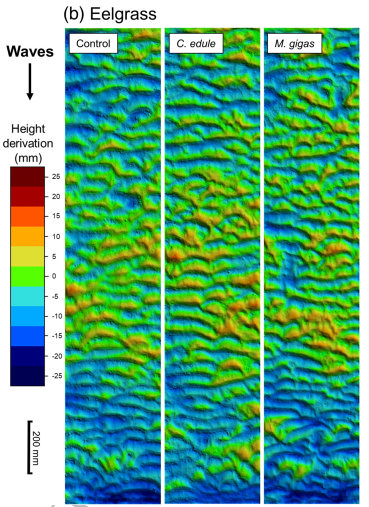ABSTRACT
Habitat forming ecosystem engineers play critical roles in structuring coastal seascapes. Many ecosystem engineers, such as seagrasses and epifaunal bivalves, are known to have positive effects on sediment stability and increase coastal protection and ecosystem resilience. Others, such as bioturbating infaunal bivalves, may instead destabilize sediment. However, despite the common co-occurrence of seagrasses and bivalves in coastal seascapes, little is known of their combined effects on sediment dynamics.
Here, we used wave flumes to compare sediment dynamics in monospecific and multispecific treatments of eelgrass, Zostera marina, and associated bivalves (infaunal Limecola balthica, infaunal Cerastoderma edule, epifaunal Magallana gigas) under a range of wave exposures. Eelgrass reduced bedload erosion rates by 25-50%, with digital elevation models indicating that eelgrass thereby affected the sediment micro-bathymetry by decreasing surface roughness and ripple sizes. Effects of bivalves on sediment mobilization were species-specific; L. balthica reduced erosion by 25%, C. edule increased erosion by 40%, while M. gigas had little effect.
Importantly, eelgrass modified the impacts of bivalves: the destabilising effects of C. edule vanished in the presence of eelgrass, while we found positive additive effects of eelgrass and L. balthica on sediment stabilisation and potential for mutual anchoring. Such inter-specific interactions are likely relevant for habitat patch emergence and resilience to extreme wave conditions. In light of future climate scenarios where increasing storm frequency and wave exposure threaten coastal ecosystems, our results add a mechanistic understanding of sediment dynamics and interactions between ecosystem engineers, with relevance for management and conservation.







